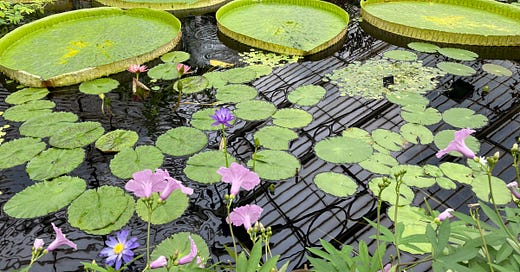Drawing is seeing
How a team of scientists - and an artist - worked together to describe a new species of waterlily

For me, there’s nothing more delicious than when art and science work together.
The perfect partnership of art and science, botanical illustration has existed for as long as we’ve been systematically naming and describing plants, and continues to have a role in scientific research to this day.
Many botanical artists are scientists themselves, and so understand the exact features of a plant – which they reproduce on paper in stunningly accurate detail, perfectly replicating scale and colour – are of most interest to the botanists they’re working with, allowing them to make comparisons between species. While photography has its uses, it can’t always pick out these crucial, minute details to the required degree for doing science.
“Drawing is seeing. The minute you put pencil to paper, you are describing what you are seeing,” says botanical artist Lucy Smith, whose illustrations of waterlilies contributed to the description of a new species this year.
Smith started drawing the waterlilies and their flowers in Kew Gardens’ Waterlily House back in 2016. As the flowers bloom after dark, and only fleetingly, she had to put in a few late nights to catch them. Once open, they change rapidly, allowing just enough time for beetles to arrive, do their pollination thing, and leave.
By 2019 she had drawings of the two known species of waterlilies from the genus Victoria – amazonica and cruziana – as well as another that Kew horticulturalist Carlos Magdalena had grown from a seed sent from a botanical garden in Bolivia, assumed to be another cruziana. Magdalena had long suspected there was a third species in the Victoria family. After making her drawings, so did Smith. The leaves and flowers of this specimen from Bolivia were different, she noted in a blog about the Victoria project, but “it was difficult to say how”.
With the help of DNA analysis, citizen science and careful examination of the plants’ form and structure, it was concluded that the assumed cruziana was indeed a new species, just as Smith and Magdalena had thought, which was named V. boliviana.
reading list
“People forget chess is a sublimation of war and a ritual encounter with death.” Memes are far more powerful than we might give them credit for. This tragic case of poisoning led to safer drugs in the US. How music has been used to control and harass. The history and surprising origins of macaroni cheese.
something to chew on
There was a material problem with earlier Scrabble sets that could arise when players selected their tiles for the next round. What were the tiles made of, and what was the problem?
The answer to the last teaser was: Abraham Lincoln and Charles Darwin. Lincoln and Darwin were both born on 12 February 1809, and their portraits have featured (or still do, in the case of Lincoln) on the bank notes of their native countries, so they have been carried by millions.
a thought
My professor of art history said to me, you know, in your life, if you’re a good artist, you have one good idea. But if you’re a genius, you maybe have two good ideas.
Marina Abramović, artist



